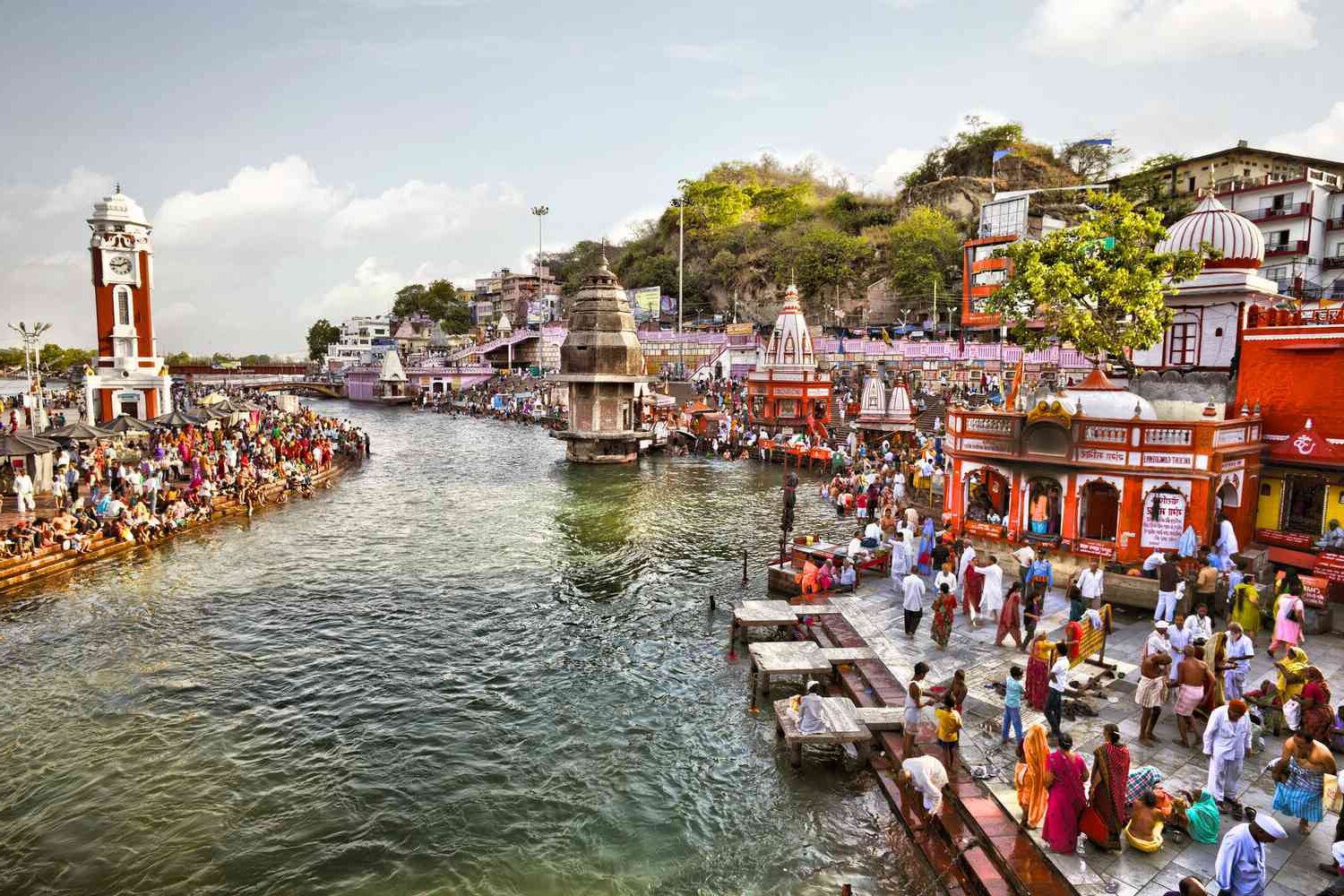Haridwar, located in the state of Uttarakhand, India, is an ancient city renowned for its religious and cultural significance. Situated on the banks of the holy River Ganges, Haridwar is considered one of the seven holiest places in Hinduism. It is often referred to as the “Gateway to God” and attracts millions of pilgrims and tourists every year.
The name “Haridwar” translates to “Gateway to Hari (Lord Vishnu)” in Sanskrit. The city is believed to be the place where Lord Vishnu left his footprint, making it a sacred site for Hindus. Haridwar is also one of the four sites where the Kumbh Mela, the world’s largest religious gathering, takes place every 12 years, drawing millions of devotees and sadhus (Hindu ascetics) from around the world.
Haridwar is steeped in mythology and has several ancient temples and ghats (riverfront steps) that hold religious significance. The most famous ghat is Har Ki Pauri, where it is believed that Lord Vishnu’s footprints are imprinted on a stone wall. Pilgrims flock to this ghat to take a holy dip in the Ganges and attend the mesmerizing Ganga Aarti (a prayer ceremony dedicated to the river) held every evening.
The city is dotted with numerous temples, each with its own historical and mythological significance. Some of the prominent temples in Haridwar include Mansa Devi Temple, Chandi Devi Temple, Bharat Mata Temple, and Maya Devi Temple. These temples attract devotees who come to seek blessings and offer prayers.
Apart from its spiritual importance, Haridwar is known for its cultural and traditional practices. The city hosts various festivals and events throughout the year, celebrating Hindu rituals and customs. The Kumbh Mela, Ardh Kumbh Mela, and Kanwar Yatra are the most significant religious events held in Haridwar, attracting devotees and sadhus in large numbers.
Haridwar is also a center for Ayurveda and yoga. Many Ayurvedic centers and yoga retreats offer holistic wellness treatments, yoga classes, and meditation sessions, providing visitors with an opportunity to rejuvenate their mind, body, and soul.
The city is well-connected by road and rail. The nearest airport is Jolly Grant Airport, located about 35 kilometers (22 miles) away in Dehradun. Haridwar is easily accessible from major cities like Delhi, Rishikesh, and Dehradun.
Best 10 Place to visit in Haridwar?
Here are ten of the best places to visit in Haridwar:
- Har Ki Pauri: Har Ki Pauri is the most famous ghat in Haridwar and is considered the holiest spot in the city. It is believed to be the place where Lord Vishnu left his footprint. Pilgrims gather here to take a holy dip in the Ganges and witness the mesmerizing Ganga Aarti in the evening.
- Mansa Devi Temple: Located atop the Bilwa Parvat Hill, Mansa Devi Temple is dedicated to Goddess Mansa Devi. It is a popular pilgrimage site and can be reached by a ropeway or by trekking up the hill. The temple offers panoramic views of the city and the Ganges River.
- Chandi Devi Temple: Situated atop the Neel Parvat Hill, Chandi Devi Temple is another important shrine in Haridwar. It is dedicated to Goddess Chandi, an incarnation of Goddess Parvati. Visitors can reach the temple by a ropeway or by trekking up the hill.
- Bharat Mata Temple: Bharat Mata Temple is a unique temple dedicated to Mother India. It features a map of undivided India carved in marble and is a symbol of unity and patriotism. The temple showcases various important landmarks of India.
- Maya Devi Temple: Maya Devi Temple is one of the oldest temples in Haridwar and is dedicated to Goddess Maya Devi, the deity of Shakti. It is believed to be the place where the heart and navel of Goddess Sati (Shiva’s consort) fell during Lord Shiva’s Tandava dance.
- Daksheshwar Mahadev Temple: Located in Kankhal, Daksheshwar Mahadev Temple is an ancient temple dedicated to Lord Shiva. It is believed to be the site of the Yagna (sacrificial fire ceremony) organized by King Daksha, the father of Sati.
- Shantikunj Ashram: Shantikunj Ashram is a renowned spiritual center and headquarters of the spiritual organization All World Gayatri Pariwar. It promotes spiritual and moral values through various activities, including meditation, yoga, and self-development programs.
- Vaishno Devi Temple: Vaishno Devi Temple is a replica of the famous Vaishno Devi Temple in Jammu and Kashmir. It is a popular pilgrimage spot and offers a spiritual ambiance for devotees.
- Sapt Rishi Ashram: Sapt Rishi Ashram is a serene and tranquil place located on the banks of the Ganges. According to Hindu mythology, it is the spot where seven sages (Sapt Rishis) meditated. The ashram is an ideal place for meditation and seeking solitude.
- Pawan Dham: Pawan Dham is a beautiful and intricately designed temple made of glass and mirror work. It is known for its exquisite craftsmanship and architectural beauty. The temple showcases scenes from Hindu mythology and is a visual delight.
- Angkor Wat – The Largest Hindu-Buddhist Temple in the World

- UNESCO World Heritage Sites

- Indian Handicrafts: A Diverse Cultural Heritage

Which month to visit in Haridwar?
Here’s a breakdown of the different seasons in Haridwar:
- Summer (April to June): Summer is the peak tourist season in Haridwar. The weather is hot, with temperatures ranging from 25°C to 40°C (77°F to 104°F). Despite the heat, Haridwar remains relatively cooler than the neighboring plains. It is an ideal time for visiting temples, attending Ganga Aarti, and exploring the city. However, be prepared for crowded streets and attractions during this time.
- Monsoon (July to September): Haridwar experiences moderate to heavy rainfall during the monsoon season. The temperature ranges from 20°C to 30°C (68°F to 86°F). The surrounding hills and the Ganges River become lush green, offering a scenic and serene atmosphere. It is a good time for nature lovers and photographers. However, be cautious of possible landslides and roadblocks during heavy rainfall.
- Autumn (October to November): Autumn is a pleasant time to visit Haridwar. The weather is mild, with temperatures ranging from 15°C to 25°C (59°F to 77°F). The monsoon rains have subsided, and the surroundings are vibrant with greenery. It is a good time for outdoor activities, sightseeing, and attending festivals like Diwali and Dussehra.
- Winter (December to February): Winter in Haridwar is chilly but pleasant, with temperatures ranging from 8°C to 20°C (46°F to 68°F). The city experiences a cold breeze from the Himalayas, but the days are generally sunny. It is an ideal time for visiting temples, attending Ganga Aarti, and exploring the city without the crowds. The evenings can be cold, so carrying warm clothing is recommended.



